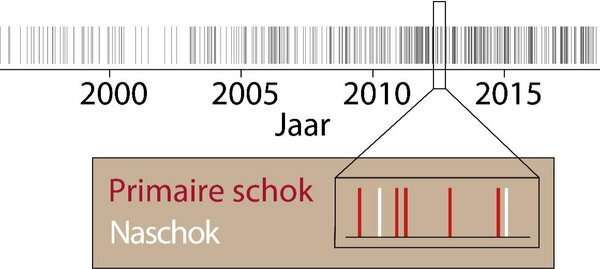Timeline with earthquakes in Groningen. For a long time it was unclear whether aftershocks occurred in Groningen or whether they were almost exclusively directly induced earthquakes. Credit: Eindhoven University of Technology
How can you distinguish primary earthquakes from aftershocks when seismic activity changes rapidly? A new mathematical modeling of earthquakes now makes this possible, developed by researchers from TU/e, TNO and the universities of Utrecht and Côte d'Azur (Nice). By specifically taking the situation in Groningen, they were able to show with this model that a non-negligible part of the quakes in Groningen were aftershocks. Until now it was unclear whether aftershocks occurred in Groningen or whether they were almost exclusively directly induced earthquakes. These insights help determine how buildings should be preventively reinforced.
The model can clarify the statistics of earthquake occurrence, particularly when these quakes are caused by human operations varying in time and place, such as gas extraction, fracking or water injection. "Our method is particularly suitable for situations where with existing methods the amount of data is insufficient for reliable conclusions," says Professor of Statistics Edwin van den Heuvel from TU Eindhoven.
The researchers applied their model to the earthquakes in Groningen, in which the role of aftershocks is still a point of discussion in the literature and the amount of data is limited.
"Applied to the catalog of the Royal Netherlands Meteorological Institute (KNMI) of quakes in the period 1995-2018, the model shows that in the Groningen field the role of aftershocks cannot be neglected," says Van den Heuvel.
This helps in estimating how often an extreme quake occurs—and therefore what a building needs to be protected against. "When there would be no aftershocks, theoretically the probability of seeing two quakes in a short time is extremely small," Van den Heuvel explains. "When there are aftershocks, this is more common. That can be reason enough to preventively reinforce buildings so they can handle a number of quakes in a short period of time."
Aftershocks obstruct visibility
Compared to geological seismicity, induced quakes are often characterized by strongly time- and place-varying operation and resulting seismic activity. This strong variation and a limited amount of data complicate the important distinction between the primary quakes directly associated with the operation and the aftershocks that occur in between, and thus hamper the view of the direct influence of human activity.
The new model is able to describe the strong variation in time and place with a limited number of parameters. In a recently published paper in Scientific Reports, the interdisciplinary collaboration explains their mathematical model and its application to the Groningen quakes.
More information: Richard A. J. Post et al. Interevent-time distribution and aftershock frequency in non-stationary induced seismicity, Scientific Reports (2021). DOI: 10.1038/s41598-021-82803-2
Journal information: Scientific Reports
Provided by Eindhoven University of Technology























